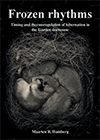PhD defence Maarten Hamberg
Maarten Hamberg (NeuBio)
Promotores: Prof. R.A. Hut, Prof. R.H. Henning (UMCG), Prof. R. Havekes

Frozen rhythms
Timing and thermoregulation of hibernation in the garden dormouse
Hibernation is used by many mammals, and for the larger part consists of torpor, where the metabolism and body temperature drop dramatically. Periodically torpor is interrupted by arousals, where body temperature is restored to ~37°C for several hours. In my first experimental chapter, I characterized how torpor and arousals differ across a variety of ambient temperatures, between -10°C and 20°C. I found that torpor phases lasts the longest around 5 to 10°C. In addition, garden dormice need to prevent freezing during torpor when the ambient temperature drops below 0°C, for which they require a strong increase in metabolic rate. In the subsequent experimental chapter, I investigated where and how circadian rhythms are present during garden dormouse hibernation. Although body temperature does not display over rhythms, the interval between arousal initiations is performed with a strong circadian gating, suggesting a persistent clock in torpor. Using phospho-proteomic analyses, I found that during torpor the liver displays circadian rhythms in both protein abundancy and protein phosphorylation, demonstrating for the first time molecular circadian rhythms in torpor. In the next chapter, I recorded brain activity of hibernating dormice to test the hypothesis that arousals occur in order to sleep. Combined with experimental sleep deprivation I demonstrated sleep homeostasis during hibernation. In the fourth chapter, I artificially elongated phases of torpor but allowing garden dormice to warm to ~30°C, which effectively prevented endogenous arousals from occurring. Collectively, this thesis sheds light on which processes dictate garden dormouse hibernation.
